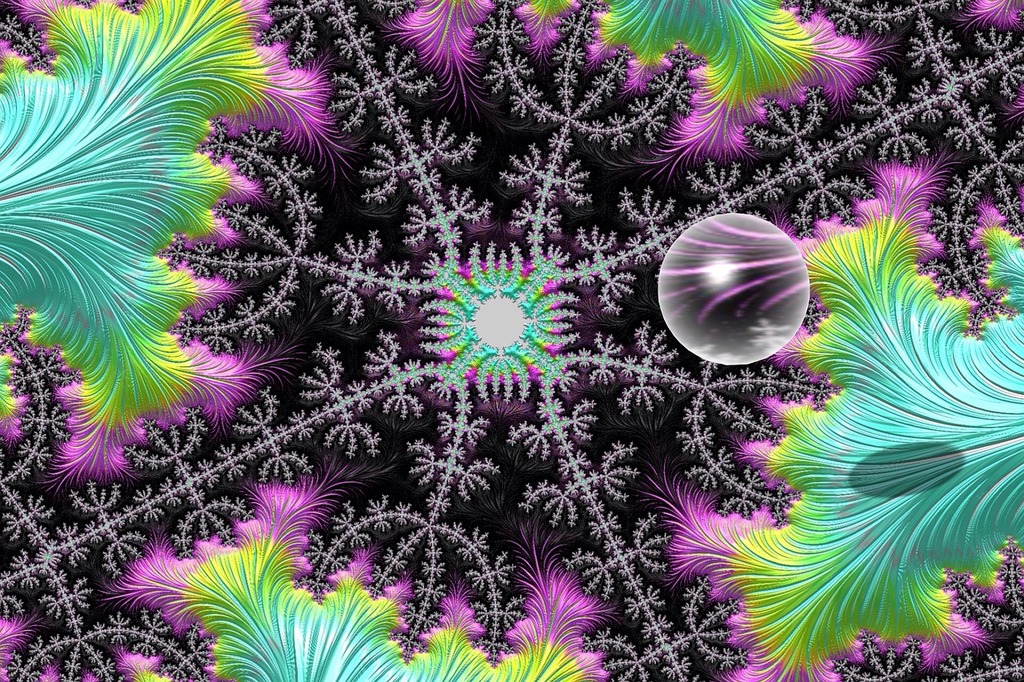When you check a leave, an entire tree root or maybe the entire tree, the lungs, arteries, river channel on maps, lightening and so on have similar design which are branching patterns. When you zoom in and out of these objects, they look alike even when viewed in different scales and we have one word for it all, Fractals. But why do we see fractals everywhere? Before you begin to say you do not understand, the image below explains what I am saying. Have you noticed that the lightening design you see in leaves are also seen in arteries, lightening and many other objects both living and non-living. That said, let's discuss it.
With fractals, it is just self-similarity in patterns that are unending in objects either when you zoom them in or out. These name was first coined by Mathematician Bernoit Mandelbrot and he gave the name to the pattern because they existed in fractured dimensions. Mandelbrot was looking at how these different shapes filled spaces at different sizes with different numbers compared to how regular dimensions interact.
For instance, if we want to increase the size of a object either in single dimension, double dimension or triple dimension, all we have to do is double the size and it increases at equal Length, Height, or Width. but with fractals, doubling its size would mean creating more fractals because its increase isn't in the dimension of 2 or 3 but rather 1.585.
While fractals look beautiful as art work, they go beyond that because they are everywhere in nature which means they can help us understand our entire world. For instance, we regard to trees as trees because how they look but then there are a lot of things that we refer to as trees that do not look similar to themselves because they are not definite in shapes and design just like we can easily identify a cube, a sphere, a circle, or a triangle but we refer to them all as trees because they look like it even when they are not the same shape and design.
Still on trees, they exhibit fractal designs as the tree creates a smaller version of its design at each level of growth. It can have a large surface area in its volume and while unlike fractals in theory and mathematics that is infinite, its isn't but it is continuous provided it keeps growing. This same thing happens to the root of trees because they require a large surface area too be able to get the nutrients they need and so, the fractal design of recreating a smaller version of itself as it grows also come into play.
Talking about living things, we also have fractals in our body and this goes from our lungs to our blood vessels. Let me quickly discuss that. In our body, our lungs does one job which is to take oxygen and send it to the blood while releasing carbon dioxide waste from the body but in other to satisfy the 15 liter oxygen needed every hour by an adult fractal branching makes it easier because if it were just two balloons tanking in air and releasing air, it might be a difficult task to accomplish but nature and evolution knows how to take care of itself.
The blood vessels the circulate blood to our body also exists in fractals. We have over 100 thousand kilometer of blood vessels in our body, and if they all large vessels, our body would not be able to contain them, also if they were all large vessels alone in the body to deliver oxygen and nutrients as well as remove waste, then we would not be able to deliver them to the smallest of regions in the body in real time. Fractal branching helps us achieve this thereby allowing enough blood with the least energy to get to where they are going to.
We can also see fractals in non-living things like creeks to rivers and oceans just to be able to collect water from a given area of land, it is also a way to split and send water to different places in rivers. Fractals are seen in ice, snow flakes, and fractals are even seen in strange mineral deposits that we sometimes mistake as plant fossils but in this case, the same fractal rule do not hold because nature is nature as you would suppose and will always come with its own rules. In the case of ice and snows, their fractals are as a result of things like temperature, chemical concentration, humidity, and so on causes them.
We are still learning fractals in living things but trust that nature decided to integrate them into itself so as to allow for things to survive and exists. Personally, I read about fractals and it got me thinking nature is beautiful in itself and although I have always seen fractals in artworks, I never really looked at it from the point of living things like me, you, your pet, or that plant you have behind your home.
Reference
https://www.ncbi.nlm.nih.gov/pmc/articles/PMC7052590/
https://arxiv.org/pdf/2402.13520v1
https://muse.jhu.edu/article/428896
https://www.scientificamerican.com/article/mandelbrot-set-1990-horgan/
https://www.pnas.org/doi/10.1073/pnas.2215047120
https://www.witpress.com/Secure/elibrary/papers/ARC06/ARC06017FU1.pdf
https://www.ncbi.nlm.nih.gov/pmc/articles/PMC8718902/
https://www.ncbi.nlm.nih.gov/pmc/articles/PMC2228620/
https://www.ncbi.nlm.nih.gov/pmc/articles/PMC4905520/
https://www.ncbi.nlm.nih.gov/pmc/articles/PMC7801417/
http://www.fractal.org/Life-Science-Technology/Publications/Fractals-and-Human-Biology.pdf
http://ijeais.org/wp-content/uploads/2024/3/IJAER240303.pdf
https://arxiv.org/pdf/2402.13520v1
https://muse.jhu.edu/article/428896
https://www.scientificamerican.com/article/mandelbrot-set-1990-horgan/
https://www.pnas.org/doi/10.1073/pnas.2215047120
https://www.witpress.com/Secure/elibrary/papers/ARC06/ARC06017FU1.pdf
https://www.ncbi.nlm.nih.gov/pmc/articles/PMC8718902/
https://www.ncbi.nlm.nih.gov/pmc/articles/PMC2228620/
https://www.ncbi.nlm.nih.gov/pmc/articles/PMC4905520/
https://www.ncbi.nlm.nih.gov/pmc/articles/PMC7801417/
http://www.fractal.org/Life-Science-Technology/Publications/Fractals-and-Human-Biology.pdf
http://ijeais.org/wp-content/uploads/2024/3/IJAER240303.pdf




